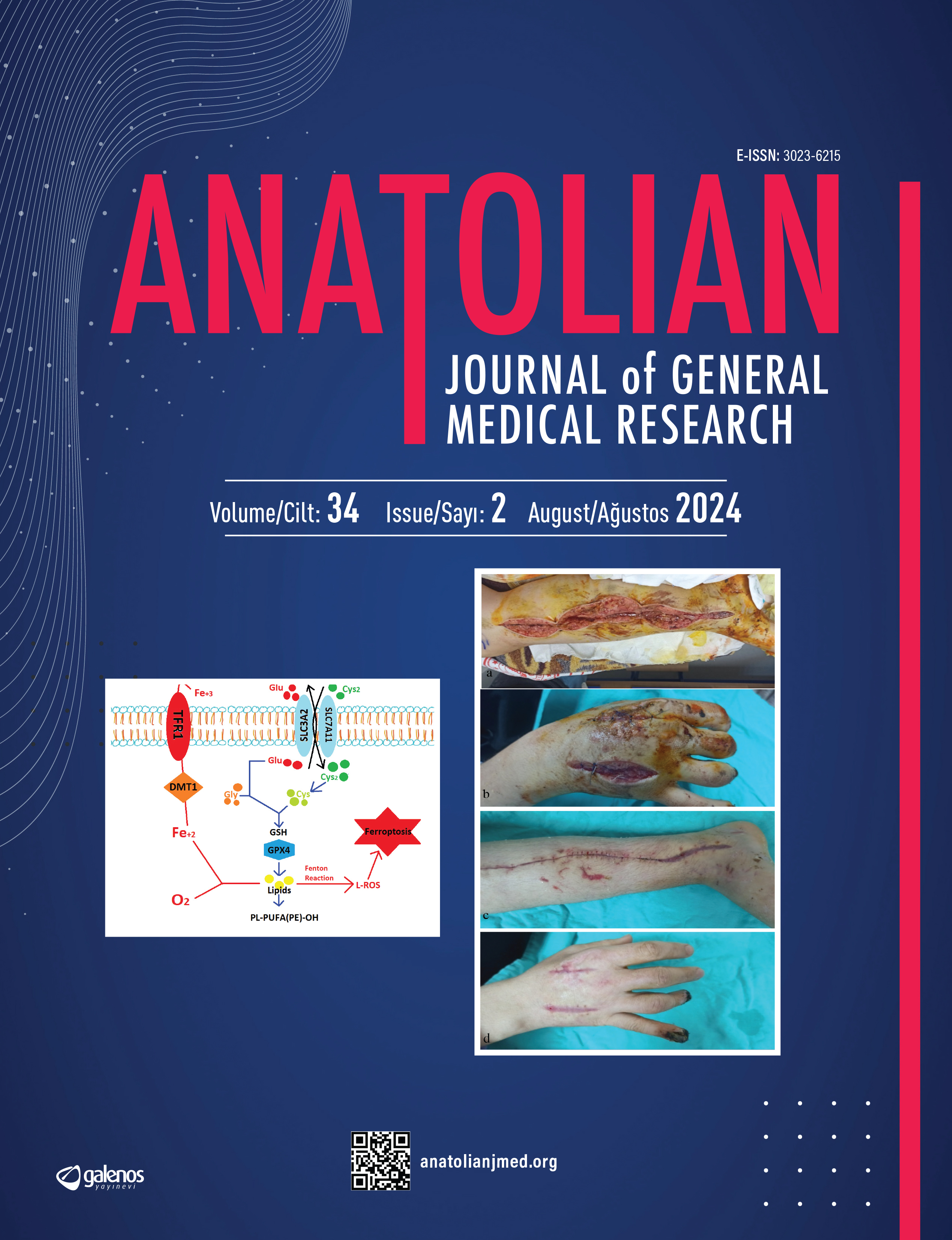








Thorax Radiography, High Resolution Tomography and Emphysema Score Measurement in Chronic Obstructive Pulmonary Disease
Yasemin Yıldırım1, Dursun Alizoroğlu1, Ahmet Emin Erbaycu1, Ömer Soy21The Health Sciences University, Faculty Of Medicine, Dr. Suat Seren Chest Diseases And Thoracic Surgery Training And Research Hospital, The Department Of Chest Diseases2The Health Sciences University, Faculty Of Medicine, Dr. Suat Seren Chest Diseases And Thoracic Surgery Training And Research Hospital, The Department Of Radiology
INTRODUCTION: The aim of this study was to determine the type and extent of emphysema and to investigate the contribution of high resolution computed tomography (HRCT) to diagnosis, compliance with chest X-ray and pulmonary function tests (PFT).
METHODS: Chest X-ray, HRCT, PFT and arterial blood gase analysis were performed. A visual scoring system was used to determine the emphysema grades in HRCT.
RESULTS: Forty-eight patients enrolled in the study were divided according to the severity of emphysema. 17 (35.4%) patients were mild, 17 (35.4%) were moderate and 14 (29.2%) had severe emphysema. Accompanying signs were nonseptal lines, bronchiectatic changes, bullae, nodule, septal lines, pleural thickening, ground glass; respectively. The mean diameter of the right pulmonary artery was 17.18 mm, the diameter of the left pulmonary artery was 17.38 mm, the diameter of the antero-posterior chest wall was 20.12 cm, the vertical diameter was 25.12 cm, the vertical diameter of the heart was 13.08 cm and the ratio of the vertical diameter of the heart to the chest vertical diameter was 0.51.
When the patients were divided into two groups as normal chest X-ray and not, emphysema score was detected 41.2 in the first group and 24.1 in the second. The forced expiratory volüme first second / forced vital capacity ratio was lower in patients with high emphysema scores. The partial carbondioxide level was lower in patients with high emphysema scores.
DISCUSSION AND CONCLUSION: There was a significant negative correlation between the prevalence of emphysema and PFT findings. HRCT is a more sensitive and specific examination method than the standard chest radiograms in the diagnosis, type, prevalence and severity of emphysema. Differential diagnosis of other pulmonary diseases leading to the same clinical feature with chronic obstructive pulmonary disease can be easily performed, and bullae not visible on chest x-ray often can be detected by HRCT.
Kronik Obstrüktif Akciğer Hastalığında Akciğer Grafisi, Yüksek Rezolüsyonlu Tomografi ve Amfizem Skoru Ölçümü
Yasemin Yıldırım1, Dursun Alizoroğlu1, Ahmet Emin Erbaycu1, Ömer Soy21Sağlık Bilimleri Üniversitesi Suam, İzmir Dr Suat Seren Göğüs Hastalıkları Ve Cerrahisi Eğitim Ve Araştırma Hastanesi, Göğüs Hastalıkları Kliniği2Sağlık Bilimleri Üniversitesi Tıp Fakültesi, İzmir Dr. Suat Seren Göğüs Hastalıkları Ve Göğüs Cerrahisi Eğitim Ve Araştırma Hastanesi, Radyoloji Birimi
GİRİŞ ve AMAÇ: Çalışmamızda amfizem tipi ve yaygınlığının belirlenmesinde yüksek rezolüsyonlu bilgisayarlı tomografi (YRBT)’nin tanıya katkısı, akciğer grafisi ve solunum fonksiyon testleri (SFT) ile uyumluluğu araştırıldı.
YÖNTEM ve GEREÇLER: Hastalara akciğer grafisi, YRBT, SFT ve arteriyel kan gazı incelemeleri uygulandı. YRBT’deki amfizem derecelerini belirlemek için görsel skorlama sistemi kullanıldı.
BULGULAR: Çalışmaya alınan 48 hasta amfizem derecesine göre üç gruba ayrıldı. 17 (%35.4) hastada hafif, 17 (%35.4) hastada orta, 14 (%29.2) hastada ağır derece amfizem saptandı. Amfizeme eşlik eden diğer YRBT bulguları sıklık sırasına göre nonseptal çizgiler, bronşektatik değişiklikler, bül, nodül, septal çizgiler, plevral kalınlaşma, buzlu cam idi. YRBT’de sağ pulmoner arter çapı ortalama 17.18 mm, sol pulmoner arter çapı 17.38 mm, göğüs ön arka çapı 20.12 cm, vertikal çapı 25.12 cm, kalp vertikal çapı 13.08 cm, kalp vertikal çapının göğüs vertikal çapına oranı 0.51 ölçüldü.
Hastalar akciğer grafisinde patoloji saptananlar ve saptanmayanlar olarak iki gruba ayrıldığında; ilk grupta amfizem skoru 41.2, ikinci grupta 24.1 ölçüldü. Amfizem skoru yüksek olanlarda zorlu ekspiratuvar volüm birinci saniye / zorlu vital kapasite oranı daha düşük bulundu. Amfizem skoru yüksek olanlarda parsiyel karbondioksit daha düşük bulundu.
TARTIŞMA ve SONUÇ: Amfizemin yaygınlığı ile SFT bulguları arasında olumsuz yönde anlamlı ilişki söz konusudur. YRBT amfizemin tanısı, tipi, yaygınlığı ve şiddetinin belirlenmesinde, standart göğüs radyogramlarına göre daha duyarlı ve özgül bir inceleme yöntemidir. Kronik obstrüktif akciğer hastalığı ile aynı klinik tabloya yol açan diğer akciğer hastalıklarının ayırıcı tanısı kolayca yapılabilmekte, çoğu zaman akciğer grafisinde görülemeyen büller YRBT ile saptanabilmektedir.
Manuscript Language: Turkish
(4158 downloaded)




